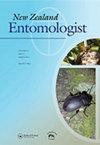不同光谱特性的荧光灯对水生和陆生成虫捕获物的比较
IF 0.4
4区 农林科学
Q4 ENTOMOLOGY
引用次数: 9
摘要
摘要研究了四种不同荧光光源对成年水生昆虫(蜉蝣目、丛翅目、毛翅目)和共生陆生昆虫(鳞翅目、鞘翅目、直翅目)的引诱效果。在采用全交叉析因设计的现场试验中,比较了黑光(BL)、黑光蓝(BLB)、冷白光(CW)和黑光/冷白光(BL/CW)组合。每种光照处理也在两个功率(强度)水平上进行评估:16W和32W。所有光照处理都吸引了属于六目的昆虫,但平均而言,BLB和BL捕获的水生昆虫是CW的近3倍,陆地昆虫大约是CW的1.5倍。组合灯通常吸引中等数量的人。总的来说,BLB最有效地吸引了蜉蝣目和毛翅目,而BL吸引了最多的陆生昆虫,尤其是鳞翅目。将灯的数量增加一倍通常会导致更大的捕获量,但并不显著(P > 0.05)。我们建议在成年水生昆虫的研究中使用BLB灯,因为它们与常规BL一样有效,并且似乎可以降低吸引非目标陆地物种的可能性;在动物群保护和更实际的样本分类方面取得了有利的结果。我们的研究结果表明,对于偏远地区的研究,16W的光照应该足以获得合理的捕获量,重要的是,可以减少携带额外设备的需要,包括重型电池。本文章由计算机程序翻译,如有差异,请以英文原文为准。
Comparison of fluorescent lights with differing spectral properties on catches of adult aquatic and terrestrial insects
ABSTRACT The effectiveness of four different fluorescent light sources, used to attract adult aquatic insects (Ephemeroptera, Plecoptera, Trichoptera) and co-occurring terrestrial insects (Lepidoptera, Coleoptera, Diptera), was investigated. Blacklight (BL), blacklight-blue (BLB), cold white light (CW) and a blacklight/cold white light (BL/CW) combination were compared in a field trial with a fully-crossed factorial design. Each light treatment was also assessed at two levels of power (intensity): 16 W and 32 W. All light treatments attracted insects belonging to the six orders, but on average BLB and BL caught nearly 3 times more aquatic insects than CW, and about 1.5 times more terrestrial insects. The combination lights generally attracted intermediate catch numbers. Overall, BLB was most effective for attracting Ephemeroptera and Trichoptera, whereas BL attracted the most terrestrial insects, particularly Lepidoptera. Doubling the number of lights generally resulted in larger catches, but not significantly so (P > 0.05). We recommend that BLB lights be used in studies of adult aquatic insects because they are as effective as regular BL and appear to reduce the likelihood of attracting non-target terrestrial species; a favourable outcome with regard to faunal conservation and, more practically, sample sorting. Our results suggest that, for studies in remote locations, 16 W of light should be sufficient to obtain reasonable catches and, importantly, reduce the need to carry additional equipment, including heavy batteries.
求助全文
通过发布文献求助,成功后即可免费获取论文全文。
去求助
来源期刊

New Zealand Entomologist
ENTOMOLOGY-
CiteScore
0.70
自引率
33.30%
发文量
3
审稿时长
>12 weeks
期刊介绍:
The invertebrate diversity of New Zealand is of great interest worldwide because of its geographic isolation and geological history. The New Zealand Entomologist plays an important role in disseminating information on field-based, experimental, and theoretical research.
The New Zealand Entomologist publishes original research papers, review papers and short communications. We welcome submissions in all aspects of science regarding insects and arthropods in a New Zealand or Australasian setting. The journal’s subject matter encompasses taxonomy, phylogenetics, biogeography, biological control and pest management, conservation, ecology and natural history.
The journal is the official publication of the Entomological Society of New Zealand. Papers published or submitted elsewhere for publication will not be considered, but publication of an abstract or summary elsewhere (e.g. conference proceedings) does not preclude full publication in the New Zealand Entomologist. Accepted papers become copyright of the Entomological Society of New Zealand. The journal is published in English, but we also welcome publication of abstracts in Maori.
 求助内容:
求助内容: 应助结果提醒方式:
应助结果提醒方式:


